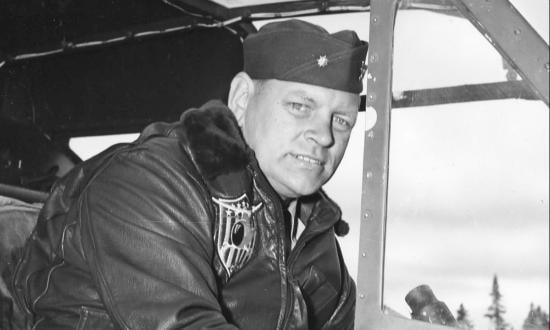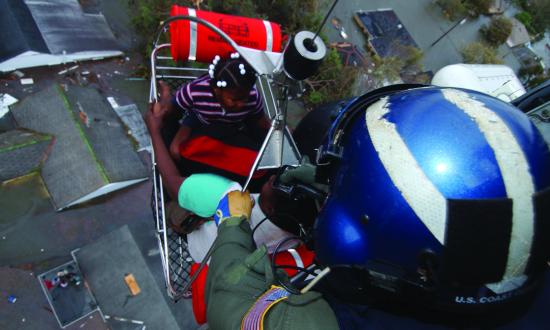(Coast Guard Historian’s Office)
After Chief of Naval Operations Admiral Ernest J. King assigned sea-going development of helicopters to the U.S. Coast Guard on 15 February 1943, naval aviation's first designated rotary-wing pilot, Coast Guard Lieutenant Commander Frank Erickson, tested and accepted the Navy's first helicopter, an HNS-1, at Bridgeport, Connecticut on 16 October later that year. Thus began a 74-year journey featuring man’s ingenuity, skill, and daring as industry and technology constantly improved the aircraft.
‘The Most Efficient Rescue Vehicles’
As northern California experienced extreme flooding in late December 1955, an HO-4S helicopter departed Coast Guard Air Station San Francisco and headed to the Yuba City area on Christmas Eve to evacuate stranded residents from inundated areas.
(U.S. Naval Institute Photo Archive)
|
HO-4S Chickasaw |
|
|
Manufacturer |
Sikorsky A/C Corp. |
|
Max. gross weight |
7,500 pounds |
|
Range |
360 miles |
|
Engine |
Pratt & Whitney 600-hp R-1340 reciprocating |
|
Max. speed |
80 knots |
|
Fuselage |
All metal |
|
Crew |
3 |
On board was the pilot, Lieutenant Commander George F. Thometz Jr.; Lieutenant Henry Pfeiffer; Chief Aviation Machinist’s Mate Joseph Accamo; and Aviation Machinist’s Mate 2nd Class Victor Rolund. During the next 12 hours, these four men pulled 138 people to safety, recovering the first 55 in darkness, with the helicopter hovering above trees, chimneys, and television antennae. The only illumination was an Aldis lamp held by the aircraft’s hoist operator. At one time, 3 women and 11 children were somehow squeezed into the helicopter—a record for an HO-4S.
This rescue proved to senior Coast Guard officials that “helicopters were the most efficient rescue vehicles of the future.” Within a few years, the service would more than triple the number of helicopters assigned to its air stations, building a dozen new facilities along the East and West coasts to ensure rapid availability.
Disaster in Galveston Bay
At 0500 on 1 November 1979, an HH-52A Seaguard helicopter scrambled to answer the distress call of two ships that had collided just outside the entrance to Galveston Bay, Texas. The aircraft and its designated Coast Guard air crew—Lieutenant J. C. Cobb, Lieutenant (junior grade) Chris Kilgore, and Aviation Electrician’s Mate 2nd Class Tom Wynn Jr.—were airborne less than 15 minutes after receiving the alert.
They arrived on scene to find the Liberian freighter Mimosa and tanker Burmah Agate on fire. The tanker suddenly exploded, an intense cloud of fire mushrooming so close to the helicopter that it lost lift and altitude. Two people were quickly located at the ship's stern. The helicopter hoist operator swung its rescue basket to them several times before they finally leaped off the railing and climbed in. No other survivors were found.
|
HH-52 A Seaguard |
|
|
Manufacturer |
Sikorsky A/C Corp. |
|
Max. gross weight |
8,300 pounds |
|
Range |
270 miles |
|
Engine |
T-58 GE-5 730-hp turboshaft |
|
Max. speed |
90 knots |
|
Fuselage |
All metal |
|
Crew |
3 |
On board the Mimosa, a group of men clustered together on the ship’s bridge. The freighter was out of control, steaming in circles around her dropped anchor, and a tangle of cargo cranes were on her deck. The hoist operator lowered the basket several times, as the helicopter followed the ship around in a circle. Eventually, the aircrew recovered 12 people—far more than the HH-52A’s small cabin could handle. Using maximum power available, the helicopter slowly climbed to 300 feet, landed on a nearby oil rig, and delivered the survivors to safety. It made two more trips to the Mimosa, rescuing ten more people before it had to return to Coast Guard Air Station Houston to refuel.
HH-52A serial number 1426 is now on display in the Boeing Aviation Hangar at the Smithsonian National Air and Space Museum’s Steven F. Udvar-Hazy Center, Chantilly, Virginia.
All-Out Rescue Effort
The Dutch cruise ship Prinsendam was steaming through the Gulf of Alaska when a fire erupted in her engine room near midnight on 4 October 1980. The vessel’s captain ordered lifeboats deployed and 520 people—320 passengers and 200 crew members—to abandon ship. The Prinsendam was more than 150 miles from the nearest coast.
|
HH-3F Pelican |
|
|
Manufacturer |
Sikorsky A/C Corp. |
|
Max. gross weight |
22,000 pounds |
|
Range |
300 miles |
|
Engine |
T-58 GE-5 1,500-hp (each) turboshaft |
|
Max. speed |
140 knots |
|
Fuselage |
All metal |
|
Crew |
4 |
The Coast Guard immediately ordered aircraft and vessels under way in what would become one of the largest rescue operations in U.S. history. Coast Guard HH-3F helicopters and fixed-wing aircraft launched immediately from Alaska’s Coast Guard Air Stations Sitka and Kodiak. The Coast Guard cutters Boutwell (WHEC-719), Mellon (WHEC-717), and Woodrush (WLB-407) were diverted to the scene, and Canadian and U.S. Air Force aircraft also responded.
Over the next 24 hours, the helicopters and vessels rescued all 520 people. None of the passengers sustained serious injuries, with winds in excess of 35 mph and seas over 15 feet.










